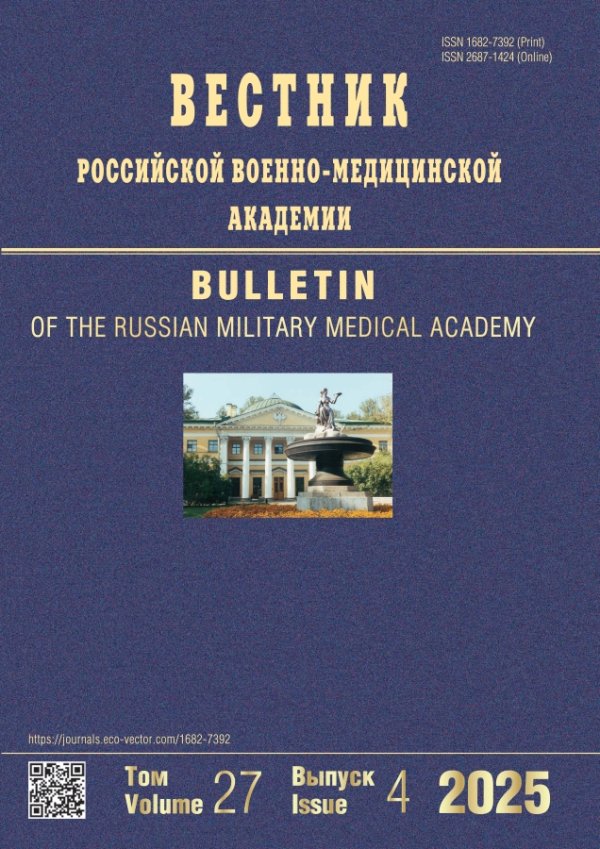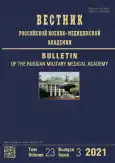Холедохолитиаз: современные возможности диагностики и хирургического лечения
- Авторы: Жеребцов Е.С.1, Ромащенко П.Н.1, Майстренко Н.А.1
-
Учреждения:
- Военно-медицинская академия имени С.М. Кирова МО РФ
- Выпуск: Том 23, № 3 (2021)
- Страницы: 109-116
- Раздел: Клинические исследования
- URL: https://journals.rcsi.science/1682-7392/article/view/74767
- DOI: https://doi.org/10.17816/brmma74767
- ID: 74767
Цитировать
Аннотация
Изучены различные подходы в диагностике и хирургическом лечении больных желчнокаменной болезнью, осложненной холедохолитиазом, дана оценка возможностям применения современных методов лечения заболевания и предложена стратегия профилактики оставления конкрементов желчевыводящих протоков. Актуальность данной проблемы обусловлена разнообразием методов диагностики и хирургического лечения холедохолитиаза, высокой частотой заболевания и отсутствием единого подхода к обследованию и выбору метода хирургического лечения больных желчнокаменной болезнью, осложненной холедохолитиазом, что определяет необходимость изучения данной проблемы и выявления оптимальных подходов к обследованию и лечению, в том числе с использованием современных минимально инвазивных методов лечения. Анализ диагностической ценности различных методов обследования и результатов операций основывался на опыте лечения 154 больных желчнокаменной болезнью, осложненной холедохолитиазом, в клинике факультетской хирургии имени С.П. Федорова Военно-медицинской академии имени С.М. Кирова. На основании полученных данных о диагностической ценности различных методов исследования сформирован алгоритм обследования больных желчнокаменной болезнью, позволяющий своевременно выявить холедохолитиаз. Проанализированы результаты различных подходов к хирургическому лечению больных желчнокаменной болезнью, осложненной холедохолитиазом. Установлено, что при отсутствии общесоматических противопоказаний и наличии технической возможности целесообразно применение одноэтапного подхода к хирургическому лечению. Определено, что при лечении больных желчнокаменной болезнью, осложненной холедохолитиазом, необходим индивидуальный подход, учитывающий характер течения заболевания и его осложнений, коморбидный статус пациента и технические возможности конкретного стационара. Последовательность и сроки операций при двухэтапном подходе должны определяться с учетом острых состояний и коморбидности пациента. Установлено, что использование современных минимально инвазивных технологий, таких, как транспапиллярная и чреспузырная холедохоскопия, дозированная папиллотомия и применение методики «рандеву» при канюлировании большого сосочка двенадцатиперстной кишки, позволяет улучшить результаты хирургического лечения и снизить риск развития осложнений. Транспапиллярная и чреспузырная наноэлектроимпульсная литотрипсия являются альтернативными способами разрешения крупного холедохолитиаза как при одноэтапном, так и при двухэтапном лечении.
Полный текст
Открыть статью на сайте журналаОб авторах
Евгений Сергеевич Жеребцов
Военно-медицинская академия имени С.М. Кирова МО РФ
Автор, ответственный за переписку.
Email: zherebtsoves@gmail.com
ORCID iD: 0000-0002-8276-4279
SPIN-код: 3554-0000
адъюнкт
Россия, Санкт-ПетербургПавел Николаевич Ромащенко
Военно-медицинская академия имени С.М. Кирова МО РФ
Email: romashchenko@rambler.ru
ORCID iD: 0000-0001-8918-1730
SPIN-код: 3850-1792
доктор медицинских наук, профессор
Россия, Санкт-ПетербургНиколай Анатольевич Майстренко
Военно-медицинская академия имени С.М. Кирова МО РФ
Email: nik.m.47@mail.ru
ORCID iD: 0000-0002-1405-7660
SPIN-код: 2571-9603
доктор медицинских наук, профессор
Россия, Санкт-ПетербургСписок литературы
- Manes G., Paspatis G., Aabakken L., et al. Endoscopic management of common bile duct stones: European Society of Gastrointestinal Endoscopy (ESGE) guideline // Endoscopy. 2019. Vol. 51, No. 5. P. 472–491. doi: 10.1055/a-0862-0346
- Williams E., Beckingham I., Sayed G.E., et al. Updated guideline on the management of common bile duct stones (CBDS) // Gut. 2017. Vol. 66, No. 5. P. 765–782. doi: 10.1136/gutjnl-2016-312317
- Lammert F., Acalovschi M., Ercolani G., et al. EASL Clinical Practice Guidelines on the prevention, diagnosis and treatment of gallstones // J Hepatol. 2016. Vol. 65, No. 1. P. 146–181. doi: 10.1016/j.jhep.2016.03.005
- Quaresima S. A 23-year experience with laparoscopic common bile duct exploration // HPB (Oxford). 2017. Vol. 19, No. 1. P. 29–35. doi: 10.1016/j.hpb.2016.10.011
- Бебуришвили А.Г., Зюбина Е.Н., Веденин Ю.И., и др. Мультицентровой анализ нозологической структуры синдрома механической желтухи // Вестник Волгоградского государственного медицинского университета. 2016. № 4. С. 50–54.
- Гусева Л.В., Брехов Е.И., Бурдина Е.Г., и др. Патология органов пищеварения у больных после холецистэктомии (хирургические аспекты) // Кремлевская медицина. Клинический вестник. 2019. № 1. С. 24–31. doi: 10.26269/q9kr-fm77
- Buxbaum J.L., Fehmi S.M.A., Sultan S., et al. ASGE guideline on the role of endoscopy in the evaluation and management of choledocholithiasis // Gastrointestinal endoscopy. 2019. Vol. 89, No. 6. P. 1075–1105. doi: 10.1016/j.gie.2018.10.001
- Gupta N. Role of laparoscopic common bile duct exploration in the management of choledocholithiasis // World J Gastrointest Surg. 2016. Vol. 8, No. 5. P. 376–381. doi: 10.4240/wjgs.v8.i5.376
- Ромащенко П.Н., Жеребцов Е.С. Современный подход к хирургическому лечению холедохолитиаза // Известия Российской военно-медицинской академии. 2021. Т. 40, № S1. С. 133–136.
- Османов З.А., Жеребцов Е.С. Современные малоинвазивные технологии в лечении холедохолитиаза // Известия Российской военно-медицинской академии. 2021. Т. 40, № S1. С. 245–249.
- Мерсаидова К.И., Прудков М.И., Нишневич Е.В., и др. Лапароэндоскопические вмешательства при холецистохоледохолитиазе (техника rendezvous) // Хирургия. Журнал им. Н.И. Пирогова. 2019. № 7. С. 36–41. doi: 10.17116/hirurgia201907136
- Bansal V.K., Misra M.C., Rajan K., et al. Single-stage laparoscopic common bile duct exploration and cholecystectomy versus two-stage endoscopic stone extraction followed by laparoscopic cholecystectomy for patients with concomitant gallbladder stones and common bile duct stones: a randomized controlled trial // Surg Endosc. 2014. Vol. 28, No. 3. P. 875–885. doi: 10.1007/s00464-013-3237-4
- Jiang X., Yang G., Wang K., et al. Clinical Efficacy Analysis of the Combination of the Laparoscope and Preoperative or Intraoperative Duodenoscope in the Treatment of Cholecystolithiasis with Choledocholithiasis: A Retrospective Study // J Laparoendosc Adv Surg Tech A. 2019. Vol. 29, No. 12. P. 1539–1543. doi: 10.1089/lap.2019.0541
- Zhang J.F., Du Z.Q., Lu Q., et al. Risk Factors Associated With Residual Stones in Common Bile Duct Via T Tube Cholangiography After Common Bile Duct Exploration // Medicine. 2015. Vol. 94, No. 26. P. e1043. doi: 10.1097/MD.0000000000001043
- Anderloni A., Auriemma F., Fugazza A., et al. Direct peroral cholangioscopy in the management of difficult biliary stones: a new tool to confirm common bile duct clearance. Results of a preliminary study // J Gastrointestin Liver Dis. 2019. Vol. 28, No. 1. P. 89–94. doi: 10.15403/jgld.2014.1121.281.bil
- Ishida Y., Itoi T., Okabe Y. Current Status and Future Perspective in Cholangiopancreatoscopy // Curr Treat Options Gastroenterol. 2019. Vol. 17, No. 3. P. 327–341. doi: 10.1007/s11938-019-00238-1
- Tsapaki V., Papastergiou V., Giannakopoulos A., et al. Management of difficult bile duct stones and indeterminate bile duct structures: Reduced ERCP radiation exposure with adjunct use of digital single-operator cholangioscopy // Physica Medica. 2019. Vol. 64. P. 69–73. doi: 10.1016/j.ejmp.2019.06.002
- Мартов А.Г., Гудков А.В., Диамант В.М., и др. Сравнительное исследование эффективности электроимпульсного и электрогидравлического литотрипторов in vitro // Экспериментальная и клиническая урология. 2013. Т. 4. С. 90–96
- Бабак А.И., Можаева Е.А., Расковалов Д.А., и др. Чресфистульная наноэлектроимпульсная литотрипсия в лечении холедохолитиаза // Вестник Российской военно-медицинской академии. 2019. № 1. С. 25–28.
- Майстренко Н.А., Ромащенко П.Н., Алиев А.К. Научная школа профессора С.П. Федорова. СПб.: Гуманистика, 2020. 264 с.
- Tazuma S., Unno M., Igarash Y., et al. Evidence-based clinical practice guidelines for cholelithiasis 2016 // Journal of Gastroenterology. 2016. Vol. 52, No. 3. P. 276–300. doi: 10.1007/s00535-016-1289-7
- Ромащенко П.Н., Феклюнин А.А., Майстренко Н.А., и др. Транспапиллярные эндоскопические операции: предикторы осложнений и профилактика их развития // Эндоскопическая хирургия. 2021. Т. 27, № 1. С. 40–48. doi: 10.17116/endoskop20212701140
- Sejpal D.V., Sejpal D.V., Trindade A.J., et al. Digital cholangioscopy can detect residual biliary stones missed by occlusion cholangiogram in ERCP: a prospective tandem study // Endosc Int Open. 2019. Vol. 7, No. 4. P. E608–E614. doi: 10.1055/a-0842-6450
- Прядко А.С., Майстренко Н.А., Ромащенко П.Н. и др. Малоинвазивные технологии в диагностике и лечении хронического панкреатита // Анналы хирургической гепатологии. 2012. Т. 17, № 2. С. 55–64.
- Мерзликин Н.В., Подгорнов В.Ф., Семичев Е.В. и др. Методы лечения холедохолитиаза // Бюллетень сибирской медицины. 2015. Т. 14, № 4. С. 99–109.
Дополнительные файлы








